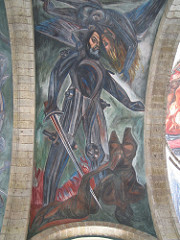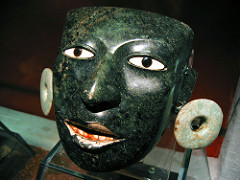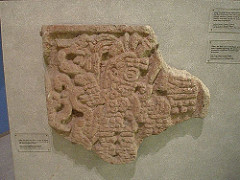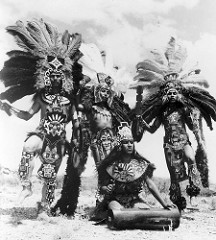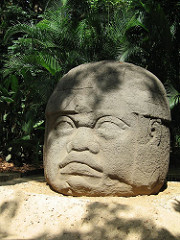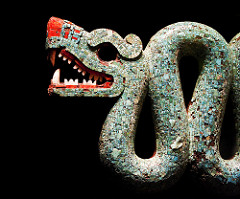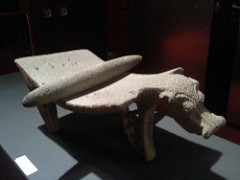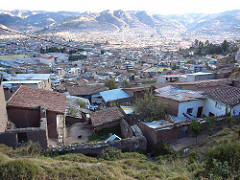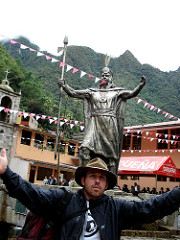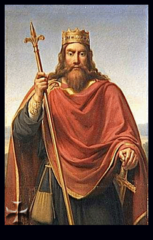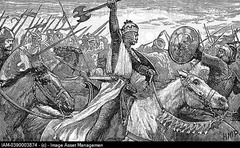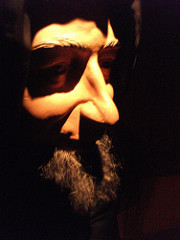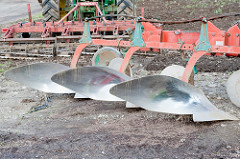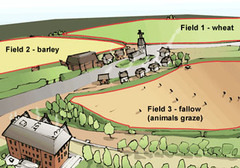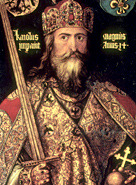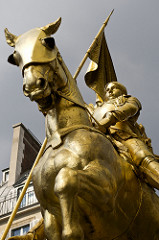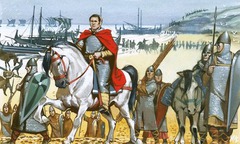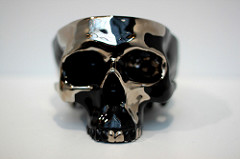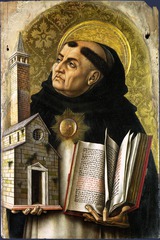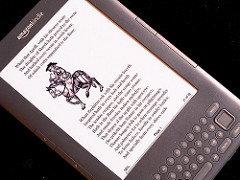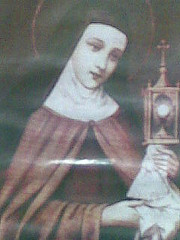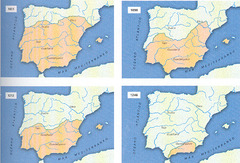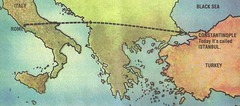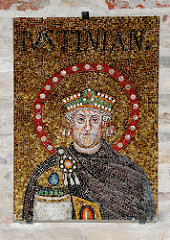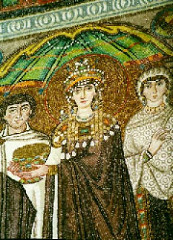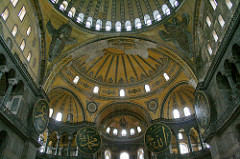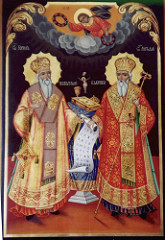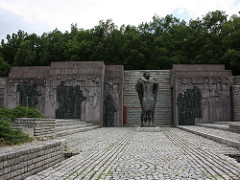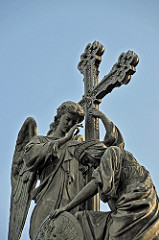Hernan Cortes
Spanish explorer and conquistador who led the conquest of Aztec Mexico in 1519-1521 for Spain. With the help of the Indian allies, he and his followers won. Although the Aztec confederacy put up a stiff resistance, disease, starvation, and battle brought the Tenochtitlan. down in 1521
Tenochtitlan
Capital of the Aztec Empire, located on an island in Lake Texcoco. Its population was about 150,000 on the eve of Spanish conquest. Mexico City was constructed on its ruins.
Lake Texcoco
A lake, now drained, in central Mexico where Mexico City now stands formally the site of the Aztec capital of Tenochtitlan, was connected to the shore by many waterways.
Teotihuacan
First major metropolis in Mesoamerica, collapsed around 800 CE. It is most remembered for the gigantic "pyramid of the sun".
Toltec Culture
Succeeded Teotihuacan culture in central Mexico; strongly militaristic ethic (set of principles) including human sacrifice; established a capital at Tula about 968;influenced large territory after 1000 C.E.; declined after 1200 C.E. Actually spread as far as Chichen Itza in the Yutacan Peninsula at some point
Topiltzin
Religious leader and reformer of the Toltecs in 10th century; dedicated to god Quetzalcoatl; after losing struggle for power; went into exile in the Yucatan peninsula. disappearance and promised return coincided with the arrival of Cortes
Quetzalcoatl
Aztec nature god, feathered serpent, his disappearance and promised return coincided with the arrival of Cortes
Tlaloc
Major god of Aztecs; associated with fertility and the agricultural cycle; god of rain
Chichen Itza
Originally a Mayan city; conquered by Toltecs circa 1000 and ruled by Toltec dynasties; architecture featured pyramid of Feathered Serpent (Quetzacoatl).
Aztecs
(1200-1521) 1300, they settled in the valley of Mexico. Grew corn. Engaged in frequent warfare to conquer others of the region. Worshiped many gods (polytheistic). Believed the sun god needed human blood to continue his journeys across the sky. Practiced human sacrifices and those sacrificed were captured warriors from other tribes and those who volunteered for the honor. Their capital was Tenochtitlan. They worshipped everything around them especially the sun. Cortes conquered them in 1521.
Olmec
The first Mesoamerican civilization. Between ca. 1200 and 400 B.C.E., they co created a vibrant civilization that included intensive agriculture, wide-ranging trade, ceremonial centers, and monumental construction. Most remembered for their large stone heads.
Moctezuma 2
1466-1520 Aztec emperor who was the last to reign the Aztec empire before it fell to Spain
Huitzilopochtli
The chief god of the Mexica or Aztec. Originally associated with war, as the empire grew, he became the Sun god and was worshiped throughout Mesoamerica. Aztecs believed he required a steady diet of human hearts.
Chinampas
Beds of aquatic weeds, mud, and earth placed in frames made of cane and rooted in lakes to create "floating islands"; system of irrigated agriculture utilized by Aztecs
Pochteca
Aztec merchants. Extremely wealthy. Had a huge quantity of material goods etc. But explicitly forbidden to take part in political hierarchy so as not to throw off the balance of power. May have sold at Tlatelolco
Calpulli
7 Clans in Aztec society, later explanded to include residential groups that distributed land and provided labor and warriors
Flowery Death
Death while taking prisoners for the sacrificial knife. It was a fitting end to a noble life and ensured eternity in the highest heaven. (A reward also promised to women who died in childbirth)
Polygamy
This form of marriage was common ONLY among the nobles, and not allowed among the peasants in Aztec society.
metates
a mortar, a ground stone tool used for processing grain and seeds; in traditional Mesoamerican culture,were typically used by women who would grind calcified maize and other organic materials during food preparation, this pointed to a lack of technological sophistication that increasingly defined and limited female Gender Roles.
The Great Speaker
The ruler of Tenochtitlan that was considered a living god. His court was magnificent and surrounded with elaborate rituals. Those who approached him could not look him in the eyes and were required to throw dirt upon their heads as a sign of humility (humbleness).
Split Inheritance
Inca practice of descent, all titles and political power went to successor, but wealth and land remained in hands of male descendents for support of cult of dead Inca's mummy, was Major reason that Inca pushed to expand,
Allyus
Incan society lived in a community, or village and family extension
Cuzco
The capital city of the Incan Empire, Located in present-day Peru
Inca
A member of the small group of Quechuan people living in the Cuzco valley in Peru who established hegemony over their neighbors to create the great Inca empire that lasted from about 1100 until the Spanish conquest in the early 1530s
Pachacuti
Ruler of Inca society from 1438 to 1471; launched a series of military campaigns that gave Incas control of the region from Cuzco to the shores of Lake Titicaca called "he who shakes the earth"
Mita
Labor extracted for lands assigned to the state and the religion; all communities were expected to contribute; an essential aspect of Inca imperial control.
Inca Socialism
A view created by Spanish authors to describe Inca society as a type of utopia; image of the Inca Empire as a carefully organized system in which every community collectively contributed to the whole.
Quipu
An arrangement of knotted strings on a cord, used by the Inca to record numerical information.
Clovis
King of Franks; conquered Gaul; earned support of Gaul and Church of Rome by converting; Ruled lands in Frankish custom but kept Roman legacy
Charles Martel
Frankish commander in the battle of Tours(Also known as Poiters). He defeated the Muslims in the Battle of Tours, allowing Christianity to survive throughout the Dark Ages. He in a way started Feudalism by giving land to his knights that served for him.
Chaucer
In England, he was a courtier, who traveled and mastered philosophy and literature. He wrote from the perspective of various pilgrims to a tomb, and uses them as individuals representing many different walks of life. He thus subtly commented on cultural, religious and literary traditions., Remembered as author of the Canterbury Tales (1340-1400)
Saint Godric
12th century Englishman who participated in urban trade but then became a religious hermit; he felt tension between religion and the state
Vikings
One of a seafaring Scandinavian people who raided the coasts of northern and western from the eighth through the tenth century.
Middle Ages
The period between the fall of the Roman Empire in the west (470) and the beginning of the European Renaissance in the 1400s. This period is also known as "Medieval."
Manoralism
System that described economic and political relations between landlords and their peasant laborers during the MIddle Ages.Large fields for agriculture, and serfs to work the land. The land and inhabitants were called a manor and both belonged to the lord.
serfs
men of women who were the poorest members of society, peasants who worked the lord's land in exchange for protection
moldboard
Heavy plow introduced in northern Europe during the Middle Ages; permitted deeper cultivation of heavier soils; a technological innovation of the medieval agricultural system.
three field system
a system of farming developed in medieval Europe, in which farm land was divided into three fields of equal size and each of these was successively planted with a winter crop, planted with a spring crop, and left unplanted.
Franks
Germanic people who lived and held power in Gaul. Their leader was Clovis and he would later bring Christianity to the region. By 511 the Franks had united into one kingdom and they controlled the largest and strongest parts of Europe.
Carolingian
of or relating to the Frankish dynasty founded by Charlemagne's father
Battle of Tours
BATTLE IN 732 IN WHICH THE CHRISTIAN FRANKS LED BY CHARLES MARTEL DEFEATED MUSLIM ARMIES AND STOPPED THE MUSLIM ADVANCES INTO EUROPE
Charlemagne
King of the Franks emperor (r. 800-814). Through a series of military conquests he established the Carolingian Empire, which encompassed all of Gaul and parts of Germany and Italy. Illiterate, though he started an intellectual revival. Was crowned Holy Roman Emperor by Pope(which would lead to problems for other rulers).
Holy Roman Empire
Loose federation of mostly German states and principalities, headed by an emperor elected by the princes. It lasted from 962 to 1806
vassals
members of the military elite who received land or a benefice from a lord in return for military service and loyalty
Normandy
A region in northwestern France on the English channel
Hundreds Year War
(1337-1453) Large war between France and England that was fueled by territorial disagreements and started when Edward III declared himself king of France. In the end, it weakened both countries for some time France WINS (Wow France Wins LOL).
William the Conqueror
He invaded England from Normandy in 1066; extended tight feudal system to England; established administrative system based on sheriffs; and established a centralized monarchy, main reason that English differs from other German languages.
Parliment
a body of representatives that makes laws for a nation, The lawmaking part of the British government
lay investiture
the practice by which secular rulers both chose nominees to church offices and gave them the symbols of their office
Black Death
The epidemic form of bubonic plague experienced during the Middle Ages when it killed nearly half the people of western Europe
Feudalism
a political system in which nobles are granted the use of lands that legally belong to the king, in exchange for thier loyalty, military service and protection of of the people who live on the land
Hanseatic League
An organization of cities in northern Germany and southern Scandinavia for the purpose of establishing a commercial alliance.
Thomas Aquinas
Italian theologian and Doctor of the Church who is remembered for his attempt to reconcile faith and reason in a comprehensive theology
The Song of Roland
One of the earliest and most famous Medieval epic poems; it's glorifies a band of french soldiers who perished after fighting the Muslims from Spain
Canterbury Tales
a book written by Geoffrey Chaucer are stories that a group of pilgrims tell to entertain eachoter as they travel to the shrine of Saint Thoman Becket in Canterbury. Fictional stories.
Romanesque Arches
Typical rounded arches are usually called.
Gothic
A style of architecture developed in northern France that spread throughout Europe between the 12th and 16th centuries.
Scholasticism
A philosophical and theological system, associated with Thomas Aquinas, devised to reconcile Aristotelian philosophy and Roman Catholic theology in the thirteenth century.
Peter Abelard
Author of Yes And No; university scholar who applied logic to problems of theology; demonstrated logical contradictions within established doctrine.
Yes and No
Peter Abelard's book; issues or Biblical statements with theological resolutions not provided, 158 theological questions—Bible & various authorities not agree. —theology enslaved to citing examples
—sought overcome limitation & reconcile authorities...
Method: 1. Pose question, 2. Cite authorities for various answers
3. Solution...
Abelard's method will be used by Scholastic movement
Clare of Assisi
Born in 1194 to a representative of an ancient roman family in Assisi, She left a wealthy life to pursue holiness through poverty after hearing Francis preach.
excommunication
The most severe penalty for refusing to obey Church laws; if this happened to you (as it did to Holy Roman Emperor Henry 4 - could not be buried on sacred ground and could not receive the sacraments.
Pope Urban 2
In The First Crusade he can be seen as one attempt to realize this vision, He was the successor to a legacy of extensive ecclesiastical reform, a legacy unpopular with many powerful people, he tried to reclaim Jerusalem from the Muslims
Reconquista
The effort by Christian leaders to drive the Muslims out of Spain, lasting from the 1100s until 1492. Ended with Ferdinand and Isabella who unified it into a powerful nation state. Ended with the fall of the Sultanate of Grenada and coincided with the expulsion of the Jews from Spain.
Constantinople
Previously known as Byzantium, Constantine changed the name of the city and moved the capitol of the Roman Empire here from Rome. It was strategically located for trade and defense purposes. Later became the capital of the Ottoman Empire and is know known as Istanbul
Justinian
Byzantine emperor in the 6th century A.D. who reconquered much of the territory previously ruler by Rome, initiated an ambitious building program , including Hagia Sofia, as well as a new legal code, people thought he was a "moron", was married to Theodora. Wanted to recapture "Old Rome".
Procopius
Historian of the Byzantine Empire who in his "Secret History" revealed the cruelty of the autocratic system in which the emperor ruled by divine providence., Wrote two histories of Byzantine Emperor Justinian's rule. One good and sponsored by Justinian, one bad and secret.
Theodora
The wife of Justinian, she helped to improve the status of women in the Byzantinian Empire and encouraged her husband to stay in Constntinople and fight the Nike Revolt. Was seen as being overambitious, and power hungry by the public.
Hagia Sophia
Most famous example of Byzantine architecture, it was built under Justinian I and is considered one of the most perfect buildings in the world.
Cyril
Along with Methodius, missionary sent by Byzantine government to eastern Europe and the Balkans; converted southern Russia and Balkans to Orthodox Christianity; responsible for creation of written script for Slavic known as Cyrillic.
Methodius
Along with Cyril, missionary sent by Byzantine government to eastern Europe and the Balkans; converted southern Russia and Balkans to Orthodox Christianity; responsible for creation of written script for Slavic known as Cyrillic.
Magyars
Muslims who attacked Europe and converted to Christianity and established Hungary, barbarian people who migrated into southern Europe, and in the early 10th century ad occupied Hungary, from where their horsemen raided into France, Italy, Germany, and even Spain
Belisarius
One of Justinian's most important military commanders during period of reconquest of Western Europe; commended in North Africa and Italy, best general of the late Roman world, quickly destroyed Vandals in North Africa, defeated Ostrogoths in 552, , slaughted rebels in Nike Rebellion
Greek Fire
Byzantine weapon consisting of mixture of chemicals (petroleum, quicklime, sulfur) that ignited when exposed to water; utilized to drive back Arab fleets that attacked Constantinople
Bulgaria
Slavic kingdom established in northern portions of Balkan peninsula; constant source of pressure on Byzantine Empire; defeated by Emperor Basil II in 1014
tsar
From Latin caesar, this Russian title for a monarch was first used in reference to a Russian ruler by Ivan III (r. 1462-1505).
Basil II
Emperor who led the Byzantines to their last period of greatness; nicknamed "Basil the Bulgur Slayer"
Byzantine
characterized by elaborate scheming and intrigue
Icon
a representation or image of a sacred personage, often considered sacred itself; an image or picture; a symbol; a graphic symbol on a computer monitor display; an object of blind devotion
Great Schism
a period of division in the Roman Catholic Church, 1378-1417, over papal succession, during which there were two, or sometimes three, claimants to the papal office
Fourth Crusade
Initiated by Pope Innocent III six or seven years after Saladin's death; crusaders attacked Constantinople and set up their own government; Byzantine Empire restored by 1261 but never fully recovered from the fourth crusade
Kiev
Trade city in southern Russia established by Scandinavian traders in 9th century; became focal point for kingdom of Russia that flourished to 12th century.
Rurik
Legendary Scandinavian(Swedish), regarded as founder of the first kingdom of Russia based in Kiev in 855 C.E.
Rus
Slavic word for "Viking"; land Rurik the Viking ruled was called "Rus" or "Russia"
Vladimir I
Grand prince of Kiev who converted to Orthodox Christianity and made it the state religion, One of the first Czars; Tried to expand south, which conflicted with Byzantine Empire. Eventually formed deal with emperor of BE
Russian Orthodox
Church that developed under Vladimir I whose priests were trained from church leaders imported from Byzantium. This king characteristically ruled over the church as well as many major appointments, shows east west divide.
Yaroslav
Vladimir's son became a Grand Prince in A.D. 1019. Under his rule, Kievan culture reached its "Golden Age". First library established and legal system organized.
Boyars
Russian aristocrats; possessed less political power than did their counterparts in western Europe
Tatars
Mongols who captured Russian cities and destroyed the Kievan state in 1236. However, they left the Russian Orthodox church and aristocracy intact.
Greek
of or relating to or characteristic of Greece or the Greeks, actually used more in the Eastern civilization than in Western/
Siege of Constantinople
The Ottoman Empire(Sultan conquered Constantinople in 1453. Through expansion into the Balkans and the Mediterranean the Ottoman empire gained political stability. From a European perspective this event ended the Middle Ages and gave way for the Renaissance.
Russia
formerly the largest Soviet Socialist Republic in the USSR occupying eastern Europe and northern Asia
Balkans
a large peninsula in southeastern Europe containing the Balkan Mountain Range, , including Albania, Bulgaria, Greece, Romania, and Yugoslavia
Seljuk Turks
nomadic invaders from Central Asia via Persia; staunch Sunnis; ruled in the name of Abbasid caliphs from mid-11th century; able to restore political initiative to the much reduced caliphate; ended threat of Shi'a conquest
